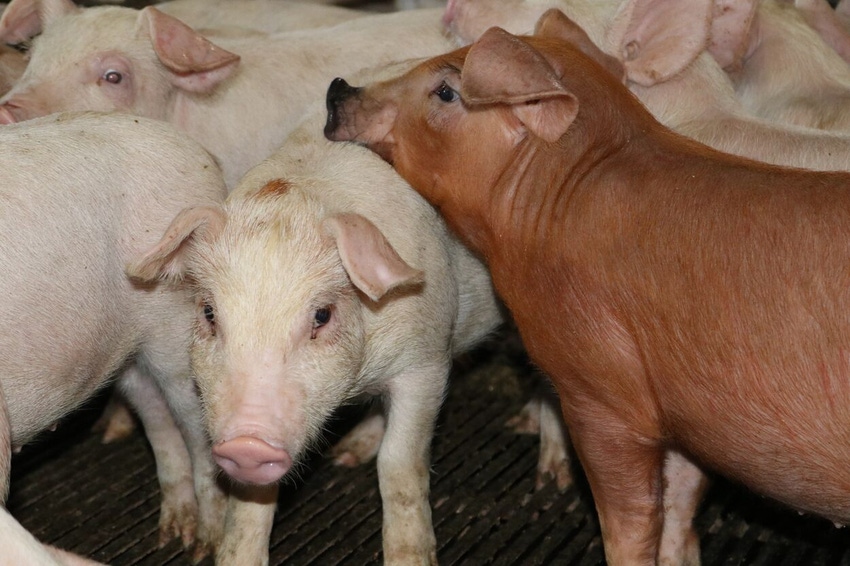Changes in genetics, new attachment mechanism may be reason for increased cases of E. coli strain.

Since 2010, the Iowa State University Veterinary Diagnostic Laboratory has seen a steady uptick in cases of the K88 and F18 strains of Escherchia coli, primarily in the nursery from 4 to 10 weeks of age. However, by 2016, cases of F18 outpaced K88, surging in 2020/2021 with more than 1,500 F18 positive isolates compared to 425 K88 positive isolates over the last two years.
According to Chris Rademacher, clinical professor at Iowa State University and associate director of the Iowa Pork Industry Center, fimbrial types, whether they're in F18 or K88, do not cause a problem as they attach to certain receptors in the intestines. It's their ability to give off toxins after they attach.
"If the F18 E.coli has the Shiga toxin gene and then it attaches to the intestinal receptor, the isolate has the ability to elaborate the toxin that can cause acute death, and edema clinical signs that are associated with that toxin gene," Rademacher says. "Early on only about a third of those F18 cases actually had the Shiga toxin gene but now we've seen here more recently, with the rise in F18, about two-thirds of those cases actually have carry the shiga toxin gene."
He says the ISU VDL is also seeing F18 cases springing up later in the nursery with high mortality in the 20-to-30-pound rage.
"One of the things that really compounds that problem is with a lot of the E. coli that we're seeing now is they're multi-drug resistant which means we don't have a lot of antibiotic options anymore," Rademacher says.
A 2020 ISU VDL Sensitivity Report showed E. coli samples were only consistently susceptible to two antibiotics, scoring 77% and 78% sensitivity, with the rest of the antibiotics susceptible less than 50% of the time.
Why so many cases of F18 now? While there has been much speculation on what's changed, Rademacher says the most consistent variable, and one that fits the timing, is a change in sire line genetics.
"When we had the last F18 wave in the late 1990s and 2000s, there were more white and Pietrain sire lines being used at that time and there's a genetic marker in the sire line for F18 resistance so they [genetic companies] were actually including that in part of their selection process and they were somewhat successful with that," Rademacher says. "Now it kind of feels like over the last two to three years, just because of some of the performance and meat quality characteristics of the Duroc, we're seeing a shift now. We've got more farms and systems moving over to the Duroc genetics which has a lot less genetic resistance down to F18."
There has also been speculation about a change in the F18 E. coli strain itself, since breakthroughs have been happening despite vaccinations. A recent Iowa State investigation into genetic fingerprinting, led by College of Veterinary Medicine's Clinical Assistant Professor Marcelo Almeida and Associate Professor Ganwu Li found a new Adhesin gene, previously not detected in pigs but found in humans, that is involved in the attachment of E. coli into the intestines.
"Now that could just be an incidental finding or it may mean something," Rademacher says. "We're in the process of trying to do some additional testing to find that out, but you know that certainly is a hypothesis that something could have changed with the recent surge in F18 E. coli."
More F18 cases could also be related to feed formulation changes. Increased pricing and supply chain disruptions recently have pressured some farms to take out or reduce some feed ingredients in diets.
Feeding for F18 challenges
According to Iowa State University Assistant Professor Laura Greiner, many producers are trying to simplify nursery diets. However, there has been some advantages to reverting back to a four-phase diet with the potential for the third phase diet having a low level of therapeutic zinc supplementation. However, caution should be noted when extending supplemental therapeutic levels of zinc beyond the first few weeks of the nursery as this can lead to lameness issues later in the grower and finisher stages.
Other feed ingredient considerations Greiner suggests:
Keeping rolled oats or rice hulls in the third phase, as those ingredients have an impact on average daily gain.
Utilize organic acids that can get to the lower gut, such as protected (encapsulated) acid.
Reduce the amount of crude protein or soybean meal in those diets to around 560 pounds in the second stage and 600 pounds in the third stage.
Consider having plasma in early diets to help protect the gut.
If producers are experiencing an E. coli challenge in the barn, Greiner says its important all pigs get the appropriate amounts of phase one and phase two. Don't mix phases in the bins or significant amounts at the feeders.
Greiner says its crucial to get pigs up and eating early — the sooner they eat the better. Pigs should be moved around three times a day at a minimum for the first few days. An attractant in the feed or gruel may be needed for tough-to-start pigs.
It's also important to keep a heat source near the feeder so they will eat and to make sure they can find water those first couple days.
Finally, Greiner say some producers have had some luck with E. coli F18 challenges by putting a citric acid product in the water as well as creep feeding in farrowing to help get the gut acclimated and to clean things up.
About the Author(s)
You May Also Like





